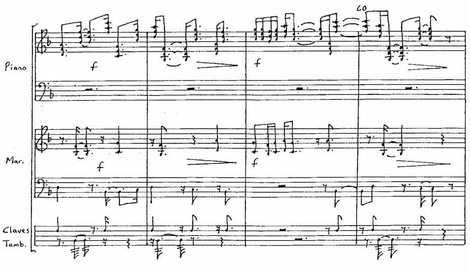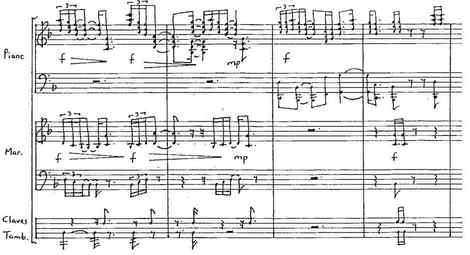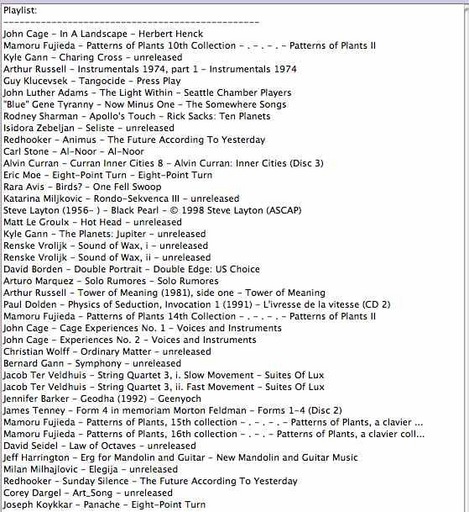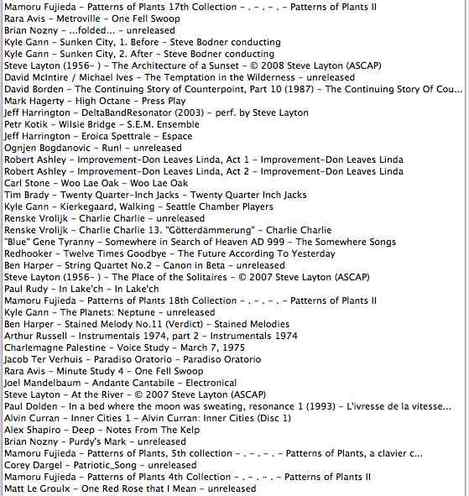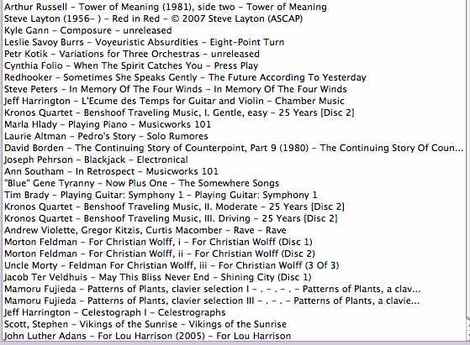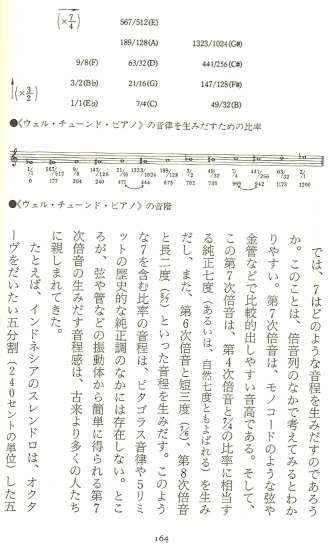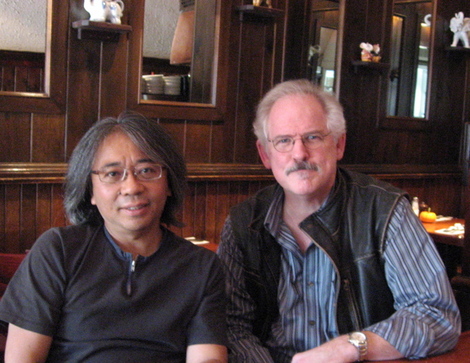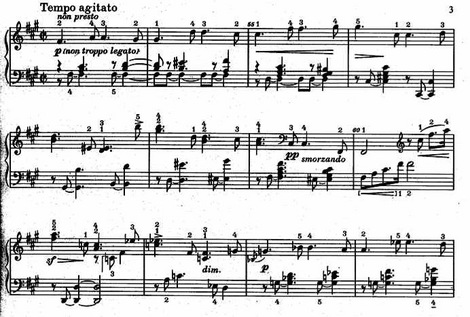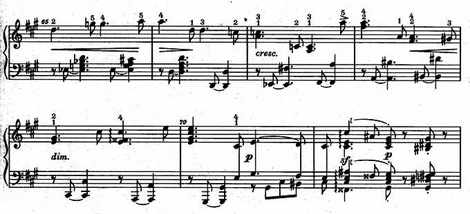October is the cruelest month. Or rather, late October/early November: my first-year students know diatonic chords and a few non-chord tones, but it’s awfully difficult to find pieces of music (even hymns!) devoid of accidentals for people still stymied by secondary dominants. One piece that I’ve found wonderful for teaching around Halloween is Barber’s Adagio for Strings – I’m not a fan of Barber or the piece, but they all know it by heart, and the film industry has done very well by it. And a lot of it stays in B-flat minor and teaches the 4-3 suspension ad nauseum:
Archives for October 2008
Thank You, Sarah Palin
We in American music owe a great debt to John McCain and Sarah Palin. Those two have so cheapened and tainted the word “maverick” that it will be at least a generation, maybe two, before anyone will be able to use the word non-ironically again. And that means, surely, that there will be no more talk about the “American maverick composers.”Â
My Unpopularity in Perspective
I had a lovely lunch yesterday with my former editor from the Voice, Doug Simmons, who hired me and edited me for seven heady years. Each of us had some anecdotes from those years we’d never told the other before. The guy who’d recommended me for the job (who might want to remain nameless in this instance) once called Doug up, furious about some new infraction I’d committed in the paper. “You’re the guy who recommended him to me,” Doug expostulated, “I’d never heard of him before.” “I think I’ve created a monster!,” the guy exclaimed, and hung up.
Beauty through Self-Limitation
The Op. 111 Club
I refuse to do those “playlist” things that tell you what I’m listening to lately, because 1. I go for long periods without listening to anything, and I’m entitled because I’ve already spent way too much of my life involved with other people’s music; 2. half of what I do listen to is for teaching reasons; 3. I often listen to pieces because I’m planning to steal ideas from them, so admitting it would sometimes be too revealing. But lately I’m listening over and over to a mammoth work that’s long fascinated me, Grand Hotel (1989)Â by Cornelis de Bondt. I found a score of it last year in Amsterdam at Donemus, and in fact, I envy the Dutch that they have such a helpful, friendly, professional institution as Donemus as a one-stop-shopping center for Dutch music. I hiked over to their spacious office (way off in an inconvenient corner of eastern Amsterdam) several times, and was welcome to listen to recordings and peruse scores for hours before buying anything. Imagine if the U.S. had a central place you could go to and look through scores by John Luther Adams, David Lang, Elodie Lauten, and almost any other American composer you could name – that’s what the Netherlands has. Although some of the younger Dutch composers have refrained from selling their scores through Donemus because, they told me, the place has gotten a reputation for representing the stodgier side of Dutch music. Given that they handle music by people as hip as Jacob ter Veldhuis, I couldn’t quite see the criticism myself, but I report what I was told. One easily imagines that if there were such a place in the U.S. it would get swamped by the officially approved orchestral New Romantic crowd of whom our elites are so dubiously proud, but Donemus struck me as admirably democratic in its absence of stylistic bias.
It’s a huge, sprawling, 37-minute essay, one of those complex pianistic virtuoso marathons mostly notated on three if not four staves, played in a frantic fury by Gerard Bouwhuis, and based on Beethoven’s Op. 111 Sonata. The opening diminished-seventh chords of that piece burst forth frequently, and many of the streams of falling 32nd-notes come from the concluding scale passages of Beethoven’s first movement. The longer (naturally) second movement is dotted with less obvious references to Beethoven’s tranquil Arioso theme, often simply sudden secondary dominant chords that hang quietly in the air. Key signatures – three flats, six sharps, five flats – run through the piece, although it more often sounds atonal than diatonic. The title, according to the liner notes, is a reference to the crumbling edifice of tonality, which certainly stands nobly, but in ruins, here. I’m told by one of his students that Cornelis de Bondt (b. 1953) teaches theory at the Hague Conservatory. I’ll upload an mp3 here for you, as is my wont, but only temporarily, for it’s a big file and I can’t spare the space forever.
Grand Hotel is a interesting contrast to Clarence Barlow’s Variazioni e un pianoforte meccanico, which is a theme and variations for live pianist and Disklavier based on the theme of Op. 111’s second movement. Barlow’s achievement is a stunning logical and technological feat, the computer grabbing data from Beethoven’s theme and composing its own cheery, sometimes almost humorous variations. Grand Hotel is far darker and more introspective, a kind of existential, manic-depressive drama featuring Op. 111’s elements in dozens of flashbacks, playing with sudden recognitions and buried shards of memory.Â
As documented here, though 95% of my musical influences are American, I’ve got my own long history of associations with Op. 111, a piece which haunts me almost as much as the Hammerklavier haunted Brahms. (Other European pieces deep in my compositional bloodstream include Mahler’s Sixth – which turned up in Custer and Sitting Bull – the adagio of Bruckner’s Eighth, Busoni’s Fantasia Contrappuntistica, Boulez’s Rituel, and everything Erik Satie wrote.) I’ve never directly quoted Op. 111 except in my Disklavier piece Petty Larceny, which consists entirely of quotations from the Beethoven sonatas, but my I’itoi Variations of 1985 was a kind of spiritual homage to it, and my two-movement piano concerto Sunken City mimicked Op. 111’s proportions and movement contrasts. In grad school, for Peter Gena’s class on the late Beethoven sonatas, I wrote a paper titled “Zen and Op. 111,” in which I analyzed the piece as a contrast between samsara and satori, between the earthly veil of illusions and the tranquility of Zen consciousness. My idea was that the first movement’s angry diminished sevenths chords represented a relentless drive to the final, sad resolution, while the arioso variations gradually defuse the polarity between tonic and dominant, creating an image of timelessness in which resolution becomes unnecessary:
(Years later, in a review of Pauline Oliveros, I described this same C-D-F-G sonority as a musical equivalent of the Yin-Yang symbol, a union of tonic and dominant with no thirds to specify major or minor.)
Obsessively quoting every historical thinker from Basho to Nietzsche and beyond, “Zen and Op. 111” was too embarrassingly immature to make public now, but at the time I was moved to write it by a book that I recently had the tremendous pleasure of rereading: R.H. Blyth’s Zen in English Literature. This is one of the books Cage read in the ’40s, and one I had discovered through his writings. Blyth was a British Japanese scholar who sat out World War II in Japan, and whose books on haiku elevated that genre to heightened visibility in the West. Zen in English Literature is an absolutely charming tome, a virtuoso display of astonishing erudition (which I tried ineffectively to imitate) in which he traces examples of Zen consciousness through Wordsworth, Dickens, Shakespeare, Keats, Blake, Pope, Donne, Milton, Chaucer, Cervantes (not English, but included anyway), and many others. Hamlet’s “There is nothing either good or bad but thinking makes it so” is the book’s continually recurring mantra, and he finds Zen in every perfectly self-forgetful artwork: “Art is frozen Zen.” No isolated example will do the book’s flavor justice, but for instance Blyth compares George Herbert’s
I made a posie, while the day ran by:
Here I will smell my remnant out, and tie
   My life within this band,
But time did beckon to the flowers, and they
By noon most cunningly did steal away
   And wither’d in my hand.
with Basho:
Leaves of the willow tree fall:
   The master and I stand listening
      To the sound of the bell.
as a type of self-identification with nature. Zen is Blyth’s poetic criterion, in fact, and for want of it he damns Coleridge as merely a sentimental pantheist.
Zen in English Literature is the liveliest and most enlightening introduction to Zen for a Westerner I’ve ever found; it’s long out of print, but I located a used copy from Amazon, and enjoyed it all over again. By Blyth’s way of thinking, Zen could be found in much (or any) great music, but there’s something special about the second movement of Op. 111 and its gradual dissolution of 19th-century goal-directed syntax. In fact, one could impose the two movements of Op. 111 as a metaphor on modernism versus minimalism, or perhaps postclassical music, in general: anxiety, portentousness, climax-orientation, and ambition versus calm, intuition, flatness, and paradoxical nonsequitur. The karma-riddled first movement is entirely classical, but the Arioso lays out a postclassical harmonic agenda many decades before the fact. Perhaps that’s why the piece has never relaxed its hold on me, and every musical work that makes reference to it demands my attention.
My Back Yard in Autumn
One of the more anti-American parts of the country:
“An earthy, jolly, quick-witted bear of a man…”
My profile of Larry Polansky is now out in the November/December Chamber Music magazine. The cover story is on Ned Rorem.
Taking Responsibility for My Influence
Someone’s applied the exact same rhythmic technique to Sarah Palin that I did to Custer.Â
Some of Us Are More Hardcore than Others
Pursuant to requests from our European affiliates, the deadline for submissions to the Second International Conference on Minimalist Music is being moved back to January 31, 2009. Thanks to all those who’ve already submitted – you’ve given us an early idea of what we can expect, and the results are already exciting. Some members of the Society, though, just found the preparation time too… too… too minimal.Â
As the Economy Contracts, PostClassic Radio Expands
There’s a lot of new interest in the songwriter/cellist/composer Arthur Russell, who died of AIDS in 1992, because of his work in dance electronica. I don’t know how far the interest extends to his early minimalist music, but I ran across my old Arthur Russell vinyl discs yesterday, and it occurred to me that I’ve never played his music on PostClassic Radio. So I’ve put two records up, Instrumentals 1974 Vol. 2, and Tower of Meaning (1981). Some of the Instrumentals have a nice beat to them, but Tower of Meaning (conducted by Julius Eastman, no less) is pretty austere, just chords in rhythm. But attractive, if you’re into the same kind of no-frills listening I am. The production values are pretty sketchy, some tracks simply cut off in mid-phrase. Imagine a big “[sic]” every time that happens, because that’s what was on the record. Part of being an expert is just having lived long enough to own the records everyone’s forgotten about. I’m sure I had these because Yale Evelev at good old New Music Distribution Service thought I should have them and sent them.
Mirror Image Around the World
Pianist Sarah Cahill has been trying to get me together with Japanese composer Mamoru Fujieda, and Saturday he and I managed to have lunch in New York. Among other points of commonality, he’s written a book on microtonality (I should say, I am currently writing a book on microtonality; I will always be writing a book on microtonality; I am so wary of the thousands of picayune errors of fact and number that my fellow microtonalists will hit me with, that I am planning to time its publication to occur mere moments before my death, so that their objections will come too late; but anyway, Mamoru has already completed one). It’s titled The Archeology of Sound, only in Japanese, and here’s his discussion of La Monte Young’s Well-Tuned Piano:
Patterns of Plants is a series of compositions based on the melodic patterns that are extracted from the data of slight changes of electric potential found in living plants. Such a procedure was made possible by “Plantron,” an apparatus conceived by bio-media artist Yuji Dogane… The compositional process… starts from finding out “musical values” in the changes of electric potential. By finding out “musical value,” I mean an attitude to regard the changes as “voices of plants” and to gather melodic patterns while listening to their voices.
Daily Challenge
[UPDATE: Anwer below] Don’t you wish your doctoral music exams could have gone on forever? I know I do. And here, just to relive a little of the thrill, is a small test reminiscent of same. If you can guess the composer’s name, you and I have a lot to talk about, but failing that, guess 1. the date of composition, and 2. the date of the composer’s birth. Here’s an mp3 of the passage so you don’t have to drag your computer to the piano.
I Do Love a Good Piece of Writing
Here’s the thing about Americans. You can send their kids off by the thousands to get their balls blown off in foreign lands for no reason at all, saddle them with billions in debt year after congressional year while they spend their winters cheerfully watching game shows and football, pull the rug out from under their mortgages, and leave them living off their credit cards and their Wal-Mart salaries while you move their jobs to China and Bangalore.
And none of it matters, so long as you remember a few months before Election Day to offer them a two-bit caricature culled from some cutting-room-floor episode of Roseanne as part of your presidential ticket. And if she’s a good enough likeness of a loudmouthed Middle American archetype, as Sarah Palin is, John Q. Public will drop his giant-size bag of Doritos in gratitude, wipe the Sizzlin’ Picante dust from his lips and rush to the booth to vote for her. Not because it makes sense, or because it has a chance of improving his life or anyone else’s, but simply because it appeals to the low-humming narcissism that substitutes for his personality, because the image on TV reminds him of the mean, brainless slob he sees in the mirror every morning.
And again:
We’re used to seeing such blatant cultural caricaturing in our politicians. But Sarah Palin is something new. She’s all caricature. As the candidate of a party whose positions on individual issues are poll losers almost across the board, her shtick is not even designed to sell a line of policies. It’s just designed to sell her.
And as a public service announcement, some much-needed publicity for the Alaska Secessionist Movement.Â



